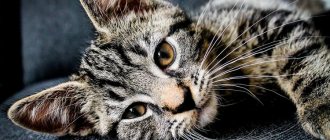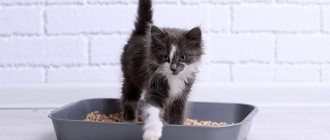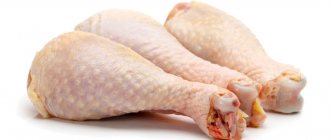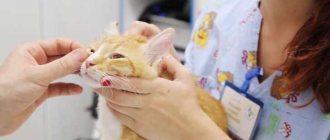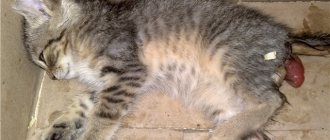What type of dandruff does cats have?
There are 3 types of dandruff in felines.
- Dry. It can be shaken off your hands and fur. Gives the animal's hair a dry, dull appearance.
- Fat. May have different thickness. Thus, the “liquid” version is manifested by a pronounced greasiness of the hairs, which are glued together. If you stroke the animal, excess secretion will remain on the palm. With increased density of dandruff (less sebaceous secretion and more skin flakes), it remains in large quantities under the owner’s nails when trying to scratch the pet.
- Mixed. The death of skin cells and the work of the sebaceous glands occur unevenly on the surface of the animal’s body, which leads to alternating dry and oily seborrhea.
Why does dandruff occur in cats?
The causes of dandruff in cats are divided into two categories: external and internal.
External
Domestic
- Poor coat care (insufficient quality combing, infrequent washing, unsanitary living conditions, etc.)
- Dry air (dry skin leads not only to seborrhea, but also cracking of the pads of the limbs)
- Ultraviolet rays (accelerate keratinization processes, dry the skin, disrupt heat exchange processes)
- Incorrectly selected animal coat care products
- Stress
- Microtrauma of the epidermis (for example, due to an incorrectly selected comb)
- Frequent bathing (leads to dry skin)
- Allergies (to food, bedding material, parasites, etc.)
- Overweight cat
- Errors in the diet
- Deficiency or excess of vitamins or minerals in food
- Disturbances in the activity of the endocrine system (diabetes, hypothyroidism and others)
- Digestive diseases
- Infections (bacterial, fungal)
- Heredity (idiopathic variant of pathology caused by genes)
- Side effect from taking medications (external or internal)
Provoking factors and causes
There are many reasons for the appearance of dandruff and they all depend on two factors - external and internal factors.
Insects in a cat's fur can cause dandruff.
External factors include:
- fungal infection;
- insects;
- sunburn;
- insufficient air humidification.
The cat has dandruff on his back closer to his tail.
Dandruff all over my back.
Dandruff on the back.
Dandruff on the tail.
A fungal infection can include microsporia, when the back and paws are affected. Ringworm can be added to this group, which mainly affects the animal’s face and tail area.
If the air in the room is too dry and not humidified , the pet’s skin becomes much rougher and denser, which causes seborrhea.
Insufficiently good care of the animal and its habitat becomes a factor in the appearance of insects - ticks or fleas, which damage the protective layer of the skin, causing damage to the sebaceous glands, and leads to seborrhea.
Spending a long time in the open sun provokes a burn, which means it damages the epidermis and sebaceous glands. Ultraviolet rays act as an accelerator of cell death.
Prolonged exposure to the sun can lead to dandruff.
Internal factors
Stress can be an internal factor of the disease.
Internal factors are pathologies that are located inside the animal’s body. These include:
- diseases of the digestive system;
- pathologies of the genitourinary system;
- hormonal imbalance;
- endocrine pathologies;
- allergic reactions;
- stress;
- reaction to medications;
- eating disorders;
- obesity.
The biggest stress for a cat is moving. After suffering from stress, dandruff may appear.
as a side effect after taking medications due to the fact that some medications, in particular shampoos, cause the skin to dry out.
A lack of foods containing fatty acids - omega-3 and omega-6 - in the menu leads to dandruff, and total hair loss is possible.
Cats and excess weight
Overweight cats are most likely to suffer from seborrhea.
Animals that are overweight suffer from seborrhea, which manifests itself mainly in the back area, closer to the tail, due to the fact that fat pets cannot take care of themselves sufficiently.
- In addition, the quality of dandruff in obese cats differs from that of their thinner counterparts.
- The scabs look greasy and are a little slippery to the touch, which slows down their sliding out of the hairline.
- Dry scales easily slide off the wool and fall off into small grains. The treatment prescribed by a veterinarian also differs according to this type.
- The presence of an oily type is visible to the naked eye - the hairline looks stuck together in greasy clumps.
- Scabs of dead skin may also vary in color. Can be painted white, yellow or gray.
Black particles
Black particles indicate the presence of a fungal infection.
The presence of black particles of the epidermis will indicate the presence of a fungal infection, parasites or acne.
Diagnosis of dandruff in cats
To cure a mustachioed pet, you need to find out why he has dandruff. And here you cannot do without the help of a veterinarian. At the clinic, the owner will definitely be asked about the cat’s living and feeding habits, favorite habits (for example, he prefers to “sunbathe” in direct sunlight), hygiene products, previous diseases, and so on.
A mandatory item will be the passing of laboratory tests (which ones - at the discretion of the doctor):
- blood for general indicators, biochemistry, hormonal changes;
- taking material from the surface of the skin;
- biopsy;
- cultural research in a nutrient medium and others.
If tests show pathological changes in the animal's body, the veterinarian may order further examination.
Is it possible to determine the cause of dandruff at home?
In the absence of a veterinarian, you can roughly find out what caused dandruff in your cat. For example, if there are light yellow scales on the pet’s body, then such seborrhea can be caused by allergies, UV radiation (from the sun), or a disorder of the internal organs.
Photo of dandruff in a cat
Black dandruff is a sign of an infectious disease caused by parasites or fungus. If this symptom occurs, the owner should immediately take the cat to a veterinarian.
If increased shedding of dead skin particles is localized near the tail, it can be assumed that the pet has received a sunburn or has contracted a fungal infection. The same location of seborrhea is observed in felines that are overweight (since it is physically difficult for the animal to reach this area).
Helminth infections, dermatomycosis, joint diseases and other pathologies can lead to dandruff, localized not only in the tail area, but also in the lumbar area. And wandering dandruff (in the form of “tracks”) on the back, face, and paws is often a sign of a subcutaneous mite.
Diagnostics
If a large number of dead epidermal scales appear on your pet’s fur, as well as other symptoms, you should contact your veterinarian. The specialist will collect anamnestic data, with increased attention paid to the cat’s nutrition, cosmetics used, and the characteristics of the pet’s habitual behavior.
A physical and external examination of the animal may reveal any abnormalities in the skin, fur, musculoskeletal system and other organ systems.
Further diagnostic search is based on the use of additional research methods. The doctor will prescribe a blood and hormone test, a cytological examination of the epidermis, in some cases a biopsy and other types of examination are required.
How to treat dandruff in cats
Treatment of dandruff in cats is carried out comprehensively and necessarily involves compliance with hygiene rules. The owner of a furry pet will have to not only provide it with medications, but also carry out a general cleaning of the room, monitor its behavior so that there is no hypothermia, overheating, contact with foreign animals, and so on.
Therapeutic measures include:
- drug treatment of the underlying disease, if it has been identified;
- taking antihistamines to relieve itching;
- taking vitamins;
- use of medicinal detergents;
- traditional methods;
- diet therapy (especially if you are overweight and have allergic dandruff);
- massage that improves blood circulation in the skin.
If the air is extremely dry, it is recommended to install a humidifier or use improvised methods.
Periodic brushing is one of the measures to prevent dandruff in cats.
Drug treatment
Medicines prescribed for the treatment of dandruff in patients with mustaches may belong to different groups. In case of inflammatory processes on the skin (dermatitis) or their high risk, the doctor will prescribe anti-inflammatory drugs, and in case of itching - antihistamines. Depending on the disease that provoked seborrhea, the following groups of medications may be prescribed:
- anthelmintics;
- antifungal;
- hormonal;
- antibacterial.
If the reason lies not in an internal disorder, but in an external factor, then, as a rule, they limit themselves to diet, folk methods and a change in hygiene products.
Vitamins for dandruff
The veterinary pharmacy today offers a huge selection of vitamin and mineral complexes that help restore the cat’s metabolism and appearance. Some of them are aimed at activating hair growth (Sherstevit), others have an antiallergic effect (for example, Veda). There are complexes that normalize the functioning of the sebaceous glands, affecting metabolic processes in general (Farmavit-neo). Taking vitamins is an essential part of treating dandruff, regardless of its cause.
Medicinal shampoos
Medicated shampoos will help rid your cat of severe dandruff. When choosing, you need to pay attention to the composition. They usually contain the following components.
Component
Action
Chlorhexidine
Antiseptic, antibacterial action.
Salicylic acid
Promotes faster rejection of dead skin particles. Has a healing effect.
Zinc
Has a healing effect. Stimulates the restoration of the epidermis.
Burr oil
It has anti-inflammatory, regenerating, hair growth stimulating effects. Softens the skin.
Plant extracts
They have a variety of therapeutic effects on hair and skin.
The most popular shampoos at the moment are: Fiprex (for external parasites), Doctor (antiseborrheic, destroys fungus), Biovax (normalizes the activity of the sebaceous glands).
Important: the therapeutic hygiene product must match the type of dandruff the cat has. Otherwise, complications may occur.
Traditional methods
Medicinal shampoos have proven themselves against dandruff
When choosing one or another traditional method of treatment, you also need to consider what type of dandruff a cat develops. For example, with dry dandruff, lactic acid, urea, and oils are used to wash the animal. If the scales are oily, drying agents are used: salicylic acid, vinegar, preparations with sulfur. In any case, rubbing oils (burdock, olives, calendula) into the hair and skin gives a good effect, since at the same time the skin is massaged, blood flow is improved, and the epidermis is cleansed.
Wool can be wiped with decoctions of medicinal plants. Often used are infusions of calendula or string, burdock, and oat decoction. Such rubbing can be done every other day. Pouring or bathing in herbal decoctions can be done once every 1-2 months. You can combine washing with a medicated shampoo and rinsing the wool with a herbal solution.
Treatment
In order for the treatment of dandruff in a cat to be successful, it is necessary to establish the cause of the disease. Only a veterinarian can do this fully. The doctor will examine the animal and, if necessary, prescribe a diagnostic examination, which may include the following medical tests:
- general blood analysis;
- blood chemistry;
- skin scraping;
- skin biopsy.
A timely visit to a specialist will help you avoid problems such as cat baldness in the future. After all, dandruff disrupts the supply of oxygen to the hair follicles, as a result of which the hair begins to actively fall out.
If a medical examination does not reveal serious diseases of the cat’s internal organs, then the veterinarian may recommend the following methods to treat dandruff:
- use of dermatological shampoos and sprays;
- dietary nutrition;
- taking vitamin complexes.
Anti-dandruff shampoos and sprays
Dermatological shampoos and sprays will help you get rid of seborrhea in your cat. The most effective means include:
- Shampoo Globalvet. The shampoo contains zinc perithione, which has a detrimental effect on pathogenic bacteria and fungi; salicylic acid, which normalizes the functioning of the sebaceous glands. The cosmetic product not only effectively eliminates dandruff, but also reduces skin itching, relieves irritation, and has a moisturizing effect. The method of application is very simple: the shampoo is applied to the animal’s fur in the required amount, massage movements are carried out for 2-3 minutes, then the product is washed off with water. The shampoo can be used daily. The average cost is 380–420 rubles for a volume of 150 ml.
Globalvet shampoo is an effective remedy for dandruff in cats
- Beaphar Anti Dandruff Shampoo. Contains natural oils of calendula, bergamot and lavender, as well as salicylic acid. The product has an anti-inflammatory and antimicrobial effect, eliminates seborrhea, and moisturizes the skin. The application regimen is similar to the method of using Globalvet shampoo. Cost - 990 rubles for a volume of 250 ml.
- Tropiclean Oxy-Med Anti-Itch Spray. Contains salicylic acid, vitamins A and E, omega-3 and omega-6 fatty acids. The spray eliminates dandruff, accelerates the regeneration of the epidermis, and quickly relieves skin itching of various origins. The product is applied to the affected areas of the skin and does not require rinsing. Cost - 600 rubles for a volume of 236 ml.
Diet food
Diet is an important element in treating any type of dandruff in a cat. To speed up the healing process, it is recommended to switch the animal to feeding natural products. So, you should actively include the following components in your diet:
- beef liver, rich in vitamins A and B;
- fish oil, including omega-3, vitamin A, antioxidants;
- vegetables: zucchini, pumpkin, broccoli, carrots.
According to veterinary nutritionists, a cat's diet should include at least 20% vegetables.
If your pet refuses to eat natural food, you should be more careful when choosing food. When using economy-class food in a cat's diet, it should be replaced with a more expensive and high-quality one. However, it should be remembered that the transition to another food should be gradual. Otherwise, you may get a side effect in the form of disruption of the gastrointestinal tract.
Vitamin complexes
Vitamin complexes will help normalize the condition of your pet’s skin, and therefore get rid of dandruff. You can opt for the following pharmaceutical products:
- vitamin and mineral complex "Radostin", which includes vitamins A, B1, B2, B6, B12, C, E; phosphorus, iron, calcium. The product is used daily. The course of treatment is 14–30 days. Product cost - 195 rubles;
The vitamin and mineral complex "Radostin" will help compensate for the lack of nutrients in a cat's body.
- vitamin and mineral complex "Polidex Multivitum", containing vitamins A, B1, B5, B12, E; calcium, iron, manganese. Dosage regimen: 1–3 times a day for 2–3 months. Next, a break is taken for 1–2 months. The vitamin-mineral complex can be used both for vitamin deficiency in cats and for preventive purposes. The price of the product is 500 rubles.
Vitamin and mineral complexes will not only help get rid of dandruff in a cat, but will also increase immunity and strengthen the musculoskeletal system.
Treatment of seborrhea in a kitten
The appearance of dandruff does not depend on the age of the pet, so it can also appear in kittens. Treatment of dandruff in babies is the same as in adult cats.
Why is dandruff dangerous for cats?
Neglected dandruff can lead to complications. One of them is hair loss, up to complete or local baldness. It happens that such places are difficult or impossible to restore in the future. Hair loss occurs due to the fact that dandruff accumulations interfere with gas exchange in the skin, causing disruption of metabolic processes and weakening of hair follicles.
Another complication is purulent inflammation of the skin, reaching the deep layers. The accumulation of dead epidermis serves as an excellent breeding ground for the proliferation of pathogenic microorganisms. Normally, they live on healthy skin, but cannot cause harm due to the good functioning of local immunity. With seborrhea, the immune system weakens, microbes multiply, redness, irritation, and itching occur. As a result of scratching, the infection penetrates even deeper - ulcers, pus, and eczema appear.
Prevention measures
The appearance of dandruff on your cat's fur can be prevented. To do this you will need:
- Brush your pet periodically, especially if it has long hair, and also during shedding;
- prevent the animal from staying in the sun for a long time;
- provide a balanced diet, sufficient amounts of vitamins and minerals;
- when feeding industrial formulations, carefully read the information about the ingredients they contain, avoiding large amounts of allergenic substances (dyes, preservatives, flavors);
- during water procedures, monitor the water temperature, preventing it from increasing;
- buy quality shampoos;
- regularly carry out prevention of internal and external parasites;
- monitor the caloric content of your cat’s food, avoiding excess weight;
- eliminate stress.
When you notice the first symptoms, you must take your cat to a veterinarian. You should not treat dandruff on your own through trial and error.
Making a diagnosis is the task of a specialist
If your cat goes for walks outside, your veterinarian may suspect ringworm, which is difficult to treat and extremely contagious. Treatment of fungal infections should be carried out by a certified specialist, and animal owners should be very responsible in fulfilling all requirements and instructions for treatment procedures, strictly adhering to the prescribed drug regimen.
When the occurrence of dandruff in a cat is associated with the development of a concomitant bacterial infection, the animal’s body odor changes.
Trying to treat a sick cat on your own, without consulting a specialist, is a futile endeavor. The veterinarian needs to take a sample of dandruff for analysis to identify the causative agent in the laboratory.
© shutterstock
The following laboratory tests will help you find out why dandruff on your cat’s back began to appear frequently and profusely:
- blood (general and biochemical analysis);
- blood test for hormone levels (if seborrhea is suspected);
- cytological analysis of a skin sample;
- biopsy;
- bacterial culture;
- analysis for fungal spores.
Only after collecting all the necessary information about the pet’s health condition and the possible causes of its disorder, it becomes possible to prescribe the correct treatment.
